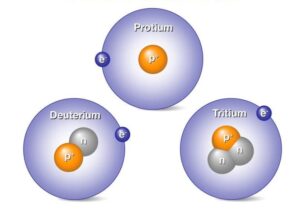Hydrogen Isotopes
There are two naturally occurring stable isotopes of hydrogen, which occur in the following proportions:
- ¹H: 99.9844%
- ²H (Deuterium): 0.0156%
Hydrogen isotopes show the largest relative mass difference between two stable isotopes. This leads to significant variations in hydrogen isotope ratios in naturally occurring materials. These isotopes are widespread in nature, present in forms like H₂O, OH⁻, H₂, and hydrocarbons.
Measurement of Hydrogen Isotopes
Hydrogen isotopes are measured in parts per thousand relative to the SMOW standard and calculated similarly to oxygen isotopes, expressed as δD ‰. Precision is usually between 1 and 2‰. The δD values for the SLAP standard relative to SMOW are -428‰. O/H ratios are typically measured on H₂ gas, produced from the reduction of water at high temperatures.
Summary of δD Values
A summary of δD values for common rock types and waters is provided. Mantle values typically range from -40‰ to -80‰, as reported by Oeloule et al. (1991). Values as low as -125‰ have also been reported. The MORB reservoir is thought to have δD = -80 ± 5‰ (Kyser and O’Neil, 1984).

Calculating the Isotopic Composition of Water from Mineral Compositions
The isotopic composition of waters from different geological settings can be measured directly as ‘fossil’ water preserved in fluid inclusions (Ohmoto and Rye, 1974; Richardson et al., 1988). However, ‘fossil’ water is usually sampled indirectly, and its isotopic composition is determined from the isotopic composition of minerals that were in equilibrium with it.
If isotopic equilibrium between a mineral and a hydrothermal solution can be assumed, laboratory calibrations of equilibria between rock-forming minerals and water can calculate the hydrothermal solution’s isotopic composition. Experimental calibrations exist for both oxygen and hydrogen isotopes, allowing precise specification of water’s isotopic composition. The calculation requires knowledge of the equilibration temperature, which may need to be estimated or measured independently using techniques like fluid inclusion thermometry.
An example is provided by Hall et al. in their study of the Climax molybdenum deposit, Colorado. Here, fluid inclusion thermometry provided the hydrothermal fluid’s temperature, and the δ¹⁸O and δD composition of the water was calculated from the isotopic composition of muscovite and sericite using muscovite-water experimental calibrations.
The Isotopic Composition of Natural Waters
The isotopic composition of natural waters can be obtained either by direct measurement or by calculation using the outlined method. Taylor (1974) describes six types of naturally occurring water, the compositions of which are summarized on a δD vs. δ¹⁸O diagram. The isotopic character of these waters can be used to trace the origin of hydrothermal solutions.

(a) Meteoric Water
Meteoric water shows the greatest variation of all natural waters. The δD-δ¹⁸O variations define a linear relationship, known as the meteoric water line, which can be represented by the expression:
\(\delta D\,(\text{‰}) = 8\delta^{18}O + 10\)(Taylor, 1979). The δ¹⁸O and δD values for meteoric water vary according to latitude. Values are close to zero for meteoric waters on tropical oceanic islands, whereas at high latitudes in continental areas, δ¹⁸O values can be as low as -20‰ to -25‰, and δD values range between -150‰ to -250‰. Both the extreme variation and the linear relationship arise from the condensation of H₂O from the Earth’s atmosphere. The extreme variation reflects the progressive lowering of δ¹⁸O in an air mass as it leaves the ocean and moves over a continent. The linearity of the relationship indicates that fractionation is an equilibrium process and that the fractionation of D/H is proportional to ¹⁸O/¹⁶O.
Ocean Water
Present-day ocean water is very uniform in composition, with values of δ¹⁸O = 0‰ and δD = 0‰. Exceptions occur in areas with high evaporation rates, such as the Red Sea, where elevated δ¹⁸O and δD values are observed, or in areas where seawater is diluted with freshwater. Muehlenbachs and Clayton (1976) suggested that ocean water’s oxygen isotopic composition is buffered by exchange with the ocean crust, a view supported by Gregory and Taylor (1981) in their study of the Semail ophiolite, Oman.

The isotopic composition of ancient seawater is less certain. Evidence from the oxygen isotope composition of marine carbonates indicates global changes in ocean isotopic chemistry during the Tertiary. These changes are believed to result from the storage of isotopically light oxygen in polar ice and are known well enough to be used as a stratigraphic tool. Similar changes are reported in the Ordovician from the oxygen isotope chemistry of unaltered brachiopod shells (Marshall and Middleton, 1990). However, uncertainties in such models, especially before the Plio-Pleistocene, include the impact of diagenetic changes on calculated former ocean water compositions (Williams et al., 1988).
Geothermal Water
Modern geothermal water is meteoric in origin but has its isotopic compositions transposed to higher δ¹⁸O values through isotopic exchange with country rocks. δD values remain the same as in the parent meteoric water or are slightly enriched. Similarly, ocean-floor geothermal systems have δ¹⁸O values between +0.37‰ and +2.37‰, close to unmodified seawater (Campbell et al., 1988).
Formation Water
Formation waters from sedimentary basins show a wide range of δ¹⁸O and δD values. Individual basins have water compositions that define a linear trend representing mixing between meteoric water and another source, such as trapped seawater, or between meteoric water and country rock.
Metamorphic Water
Attempts have been made to calculate the δD and δ¹⁸O values of water in equilibrium with metamorphic minerals across various metamorphic grades (Taylor, 1974; Rye et al., 1976; Sheppard, 1981). A combination of these values creates a metamorphic water ‘box’ with δ¹⁸O values between +3‰ and +25‰ and δD values between -20‰ and -65‰.
Magmatic Water
Calculating magmatic water composition is challenging due to interactions between magmas and groundwater. However, primary magmatic waters calculated by Taylor (1974) define a region on δD vs. δ¹⁸O diagrams between δD values of -40‰ and -80‰ and δ¹⁸O values of +5.5‰ and +9.0‰. Sheppard (1977) showed that magmatic waters associated with Permian granites of southwest England, produced by intracrustal melting, plot in a different field with δD values of -40‰ to -65‰ and δ¹⁸O values of +9.5‰ to +13‰.

